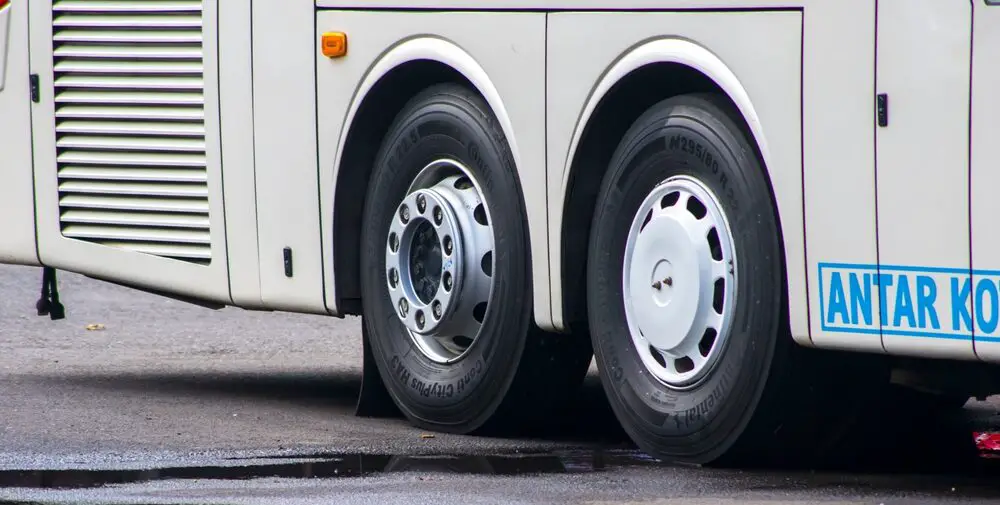
Buses come in many different shapes and sizes, but have you ever wondered how many wheels a bus actually has?
The average number of wheels installed on buses is generally between 4 and 12, spread across two or three axles. There are extreme examples of articulated buses, which are one hundred feet long and have twenty-two wheels installed on nine axles.
Whether you’re a transportation enthusiast, a curious traveler, or simply someone who wants to learn something new, you’re in the right place. Let’s go through the different types of buses and how many wheels they have.
The Number Of Wheels On A Bus
The typical number of wheels on a bus ranges from 4 to 12 depending on the type of bus and what it is used for.
There are exceptions to this, which include articulated, bi-articulated busses, as well as some which have been designed for specific routes.
The wheel counts on different-sized buses are listed in the table.
| Bus Type | Length | Driven Wheels | Total Number of Wheels |
|---|---|---|---|
| Single Decker Small Bus | 12 feet | 2 | 4 |
| Single Decker Rigid City Bus | 40 feet | 4 | 6 |
| Single Decker Articulated City Bus | 59 feet | 4 | 12 |
| Single Decker Articulated City Bus | 61 feet | 4 | 12 |
| Double Decker City Bus | 36 feet | 4 | 6 |
| Double Decker City Bus | 42 feet | 4 | 10 |
| Multi-axle bus (coaches) | 47 feet | 4 | 16 |
| Bi-articulated Van Hool ExquiCity 24 | 69 feet | 4 | 12 |
| AutoTram Extra Grand Bi-Articulated | 100 feet | 4 | 12 |
| AutoTram Extra Grand Double Decker | 101 feet | 4 | 22 |
What Factors Determine How Many Wheel A Bus Has?

There are two primary reasons why the number of wheels installed on buses varies widely:
- The length of the bus
- The gross weight (including passengers and cargo) of the bus
The Length Of The Bus
Buses used for commuting within city limits are restricted to the total length, which can realistically be maneuvered through city streets.
Even if dedicated bus lanes are used, which removes the impact city traffic has on them, they still need to maneuver around relatively sharp corners.
Rigid Busses
The rear wheels of buses with three axles that are required to regularly turn at sharp corners will have the rear wheels dragged across (laterally) the circumference of the corner. This increases the wear rate on the rear tires, making these buses less economical to run.
With rigid buses, therefore, the optimal number of axles is two, and the number of wheels ranges between four and six.
Because of this, rigid (not articulated) city buses tend to be under 45 feet in length.
Articulated Buses
Manufacturers developed articulated buses to overcome the problems of running rigid buses around sharp corners.
Articulated buses have one or two hinges along the vehicle’s length, allowing the bus to “bend” around a corner. In this regard, they resemble a vehicle with a trailer hooked up behind them.
- A normal articulated bus has a single bend.
- A bus with two “hinges” is called a tri-articulated bus.
Articulate buses range in length from under 60 feet to over 100 feet.
This adaptation has allowed some city authorities to increase the length of busses used in their area without making major changes to the road system.
The Gross Weight (Including Passengers And Cargo) Of The Bus
The difficulty with a conventional two-axle bus is that the load is placed across the whole floor, which could be as far away from the axle as 290 feet. This places substantial pressure on the bus chassis.
There are two ways the engineers could manage this:
- Build a very strong chassis
- Add More Axles
Build A Strong Chassis
It is possible to overengineer the chassis to spread the load to the two axles.
The difficulty is that it would add cost and weight to the bus. This will require higher power engines to run the bus, which, in turn, will increase gas consumption and, therefore, the cost of running it.
Add More Axles (And Wheels) Along The Length Of The Bus
By adding additional axles, the weight can be more evenly spread, resulting in the following benefits:
- It reduces overall weight
- Less powerful engines can be used, resulting in lower gas consumption
- It reduces the wear on the tires and suspension system
This is well illustrated with articulated buses:
- On a 40 feet rigid bus, the weight is shared across two axles positioned approximately 15 feet away.
- A 60-foot articulated bus (50% more capacity than the rigid bus example) will have three axles that are still only 15 feet away from each other, and therefore, each wheel carries a similar load as the shorter two-axle bus.
Why Do Buses Have Two Wheels On Each Side Of An Axle?

To make the handling of the bus manageable and to maintain its maneuverability, the front (steering) wheels are normally installed close to the front corners of the bus.
While the positioning of the front wheels provides good maneuverability, a greater portion of the load is carried by the buses’ rear axle. This includes the engine, which is generally installed at the rear.
The engineers use two wheels on each side to ensure that the bus’s rear axles can carry the load, ensuring a larger tire contact patch area is provided.
While it may seem logical to have a single, larger tire to carry the additional load, there are sound reasons why two tires are superior:
- In the event of a tire failure, two tires provide a safety margin (redundancy)
- The tire manufacturing process is geared toward standard-size tires
Conclusion
Buses have between 4 and 22 wheels, depending on their size and configuration. The number of wheels installed depends on the bus’s length and the weight it is designed to carry.
